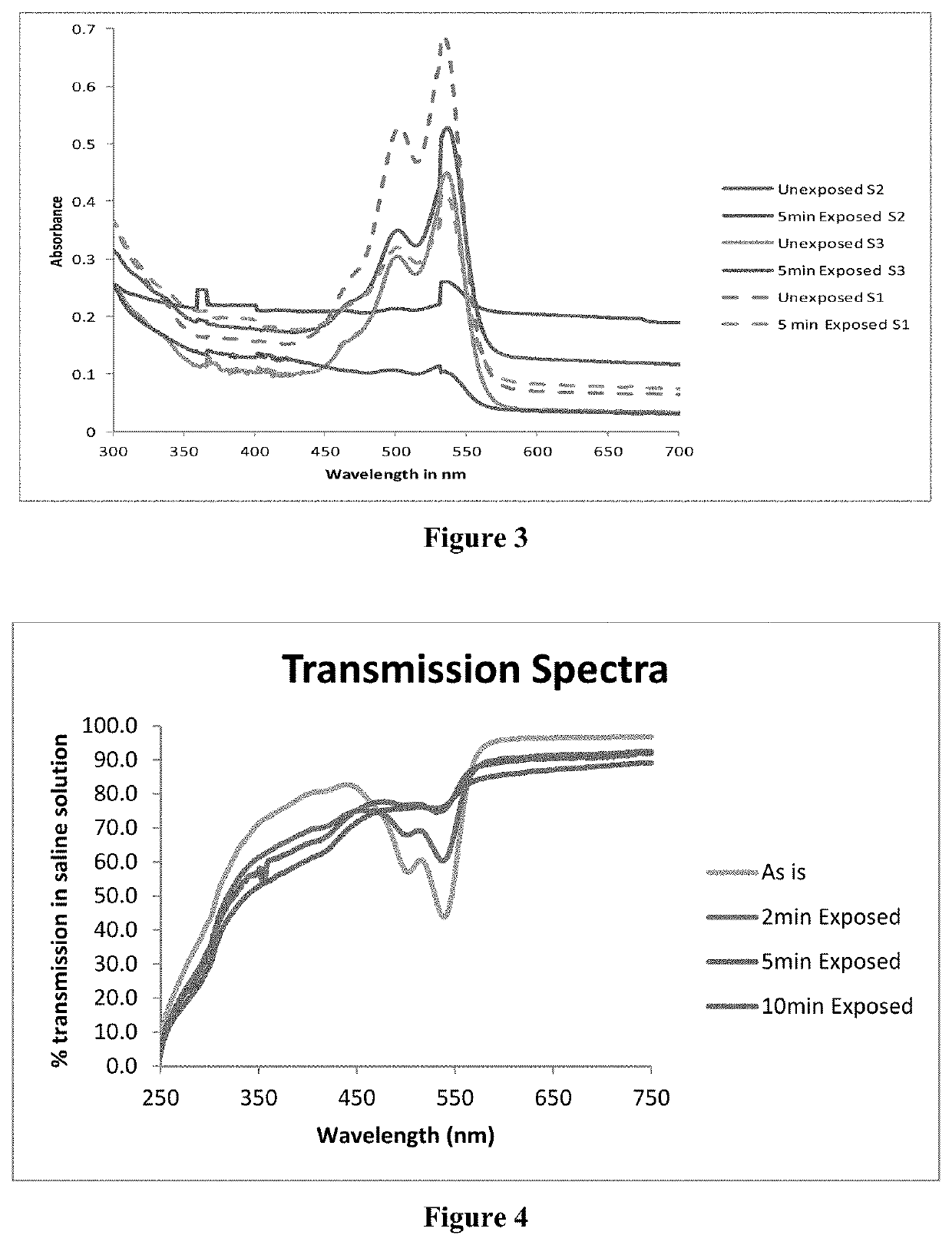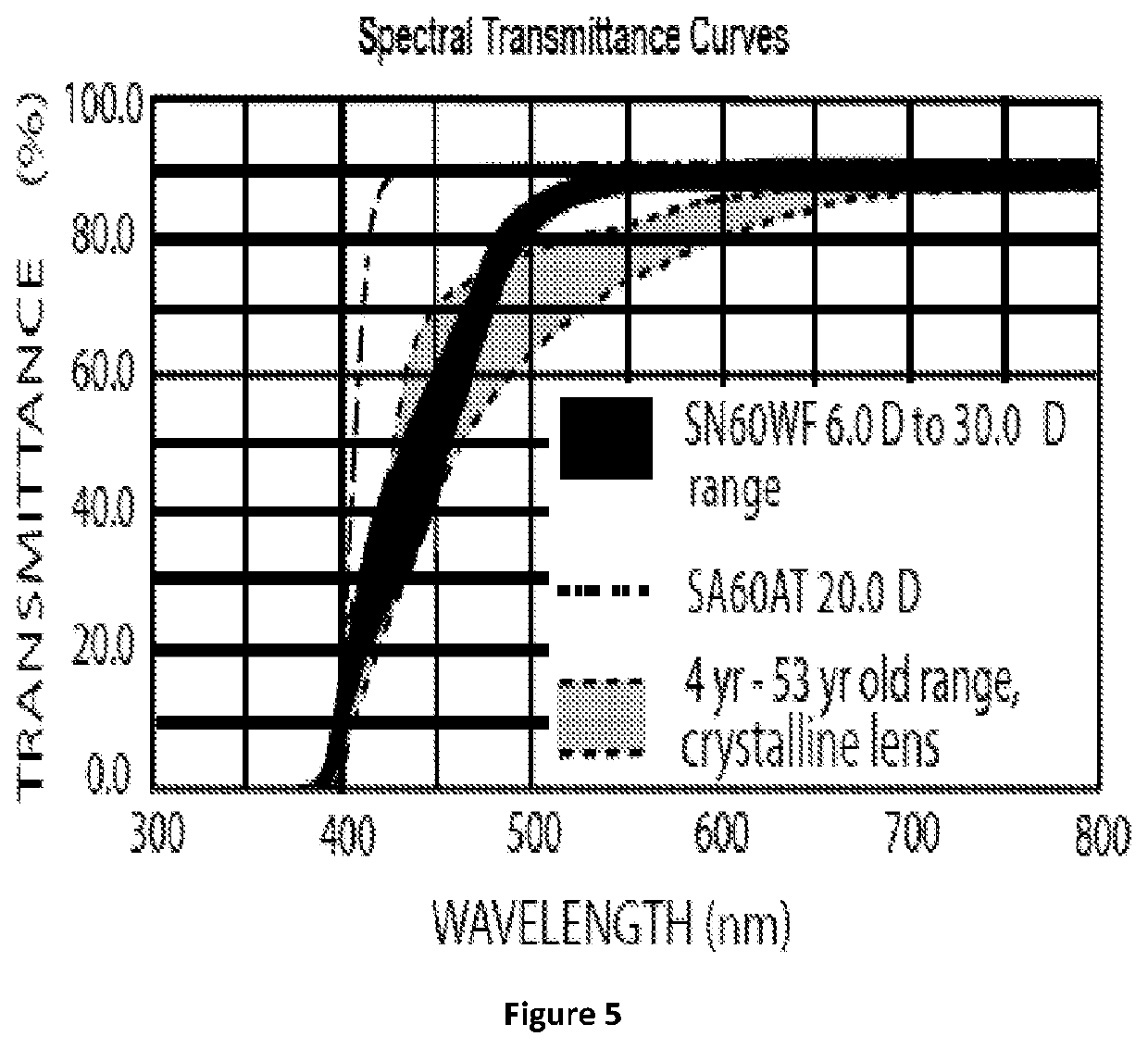Photo-responsive shape changing polymer composition for colored optical lens
a color-sensitive, polymer composition technology, applied in the direction of instruments, prostheses, photomechanical equipment, etc., can solve the problems of many limitations of colored optical lenses, difficult post-fabrication modification of lens refractive properties, and exceed the safety limits established for retinal exposur
- Summary
- Abstract
- Description
- Claims
- Application Information
AI Technical Summary
Benefits of technology
Problems solved by technology
Method used
Image
Examples
example 1
on of Modified Eosin-Y Photoinitiator
[0126]Eosin-Y (MERCK, CAS no. 17372-87-1) is insoluble in hydrophobic acrylate monomers. A hydrophobic chain was attached to Eosin-Y via an esterification reaction to make Eosin-Y soluble in hydrophobic acrylate monomers. In a 250 mL round bottom flask, 5.0 g of Eosin-Y was added in 100 mL Toluene. 10 g of Amberlyst-15-hydrogen form macroporous beads (Sigma-Aldrich, CAS no. 39389-20-3) were added. The flask was immersed in an oil bath maintained at 70° C. and stirred intermittently (once in 10 min) overnight using magnetic stirring bar. Then, 11.35 mL 2-ethyl hexane-1-ol (SD Fine chemicals; CAS no. 104-76-7) was added and a clean dean and stark apparatus was attached to the round bottom flask. The temperature of the reaction mixture was raised to 120° C. The reaction mixture was stirred intermittently once in 10 min and maintained at 120° C. for 36 hours. Amberlyst-15 and unreacted Eosin Y were removed by filtration using Whatman filter paper no ...
example 2
on of Cross-Linked Polymer Matrix Samples S1-S10
[0129]Monomer M1, monomer M2, monomer M3, crosslinker Cx, electron donor E1, hydrogen donor H1, esterified Eosin-Y (as prepared by the method described in example 1), thermal initiator R1 were mixed together in the ratios given in Table 1. The mixture was poured in a mold made using two flat glass plates separated by a Teflon spacer 1 mm in thickness. The assembly was kept in a hot air oven at 70° C. overnight. The resulting cross-linked matrix was taken out and cut into pieces of approximately 5 mm×5 mm×1 mm(1×b×h) in size.
[0130]
TABLE 1Synthesis of cross-linked polymer matrices S1 -S17NoM1 %M2 %M3 %Cx %EYE %R1 %E1 %H1 %S1EHAEHMA—EGDMA0.020.4DMAEMA—89.790.40.5S2EHA—HDDA0.020.4DMAEMA—98.20.31S3EHA——HDDA0.020.4DMAEMAHEA97.30.311S4EHA——HDDA0.020.4DMAEMA—98.60.50.5S5EHA——HDDA0.020.4DMAEMA—99.00.10.5S6BA——HDDA0.020.4DMAEMA—98.80.250.5S7BA——ED-200.020.4DMAEMA—98.8acrylate*0.50.25S8BA——HDDA0.020.4DMAEMA—99.00.10.5S9EHABA—HDDA0.020.4DMAEA—59.5...
example 5
Mechanical Properties of Cross-Linked Polymer Matrix
[0133]Mechanical properties of cross-linked polymer matrices made from compositions S4, S5, S6 and S7 were measured using a dynamic mechanical analyzer. FIG. 4 shows that in sample S6 and S7 both made from butyl acrylate, changing the type of crosslinker changed the slope of the curve i.e. the Young's modulus. Similarly, in S4 and S5 samples, changing the crosslinker density changed the break-point of the matrix.
PUM
| Property | Measurement | Unit |
|---|---|---|
| wavelength range | aaaaa | aaaaa |
| visible wavelength | aaaaa | aaaaa |
| glass transition temperature | aaaaa | aaaaa |
Abstract
Description
Claims
Application Information
 Login to View More
Login to View More - R&D
- Intellectual Property
- Life Sciences
- Materials
- Tech Scout
- Unparalleled Data Quality
- Higher Quality Content
- 60% Fewer Hallucinations
Browse by: Latest US Patents, China's latest patents, Technical Efficacy Thesaurus, Application Domain, Technology Topic, Popular Technical Reports.
© 2025 PatSnap. All rights reserved.Legal|Privacy policy|Modern Slavery Act Transparency Statement|Sitemap|About US| Contact US: help@patsnap.com



